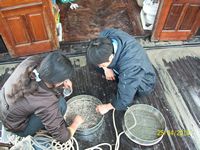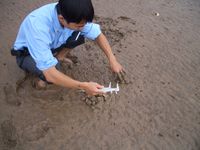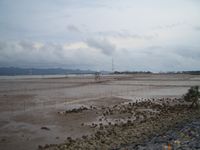|
Mercury and zinc
bioconcentration factors in hard clam (meretric
lyrata)
at BachDang estuary, VietNam
Ms. Lê Xuân Sinh
Viện Tài nguyên và Môi trường biển
246- Đường Đà Nẵng – Hải phòng
Email:
sinhlx@imer.ac.vn
1. Introduction
This
paper focuses on the assessment of accumulation of Hg and Zn in Mollusks at
Bach Dang estuary area where is polluted trap. Annual time, amount of
pollutions from continent discharge in environmental area very much.
Site
survey of geographic co-ordinate:
-
106037'00''-107000'00'‘
-
21000'00''- 20035'00''

Figure
1. Đồng Bài Cuối commune –Cát Hải
district –Haiphong.
2. Material and method
2.1. Material
|
v
Lets approach the basics methods to assess
bioaccumulation by: Experimental research and Mathematical model (USEPA, 1996a).
v
We choose
Experimental research by Static non-renewal test in 07 days period.
v
This result from thesis "Mercury
and Zinc bioconcentration factors in hard clam (meretric lyrata) at BachDang
estuary, VietNam” in 2009.
|

|
|
|
Figure 2. Monitoring of bioaccumulation of M. Lyrata in
Lab | 2.2. Method
We choose Experimental research by Static non-renewal test in 07 days period. The accumulation of contaminants in tissues of living
organisms is usually expressed as the BCF and BASF.
The accumulation of contaminants in tissues of living
organisms is usually expressed as the BCF, BAF and BASF.
Ø
BCF
= (concentration in biota)/(concentration in lab medium),
Ø
BSAF = (concentration in biota)/(concentration
in sediment medium),
2.3.
Ben Tre Hard clam (Meretrix lyrata)
|

|

|
|
Figure 2. Collect sample in the field
|
Other name of Meretrix lyrata (Sowerby, 1851) is Lyrate Asiatic,
arrange the West of Pacific Ocean, from Taiwan
to Vietnam.
Phylum: Mollusk
Class: Bivalve
Order: Heterodonta
Family:
Veneridae
Genus:
Meretrix
Species:
Meretrix lyrata
3. Results
3.1. Concentration of Hg, Zn in water of Bach Dang estuary |
|
Figure
5. Variation of Mecury from Bach
Dang River
to near shore
|
Figure
6. Variation of Zn from Bach
Dang River
to near shore
|
Concentration
of mercury in water at sampling mollusca is lower than permitted limit
(1ug/l). Slope of line decrease from mainland to sea. With sediment, concentration of mercury is over Interim Sediment
Quality Guide low (ISQGlow: 0.15ppm), but lower than ISQG ISQGhigh: 1ppm.
Resources of Hg bioaccumulation is sediment than salt mercury dissolve in
water.
Concentration
of Zn in water at sampling mollusca is higher than permitted limit
in rainy reason (50µg/l). Slope of line decrease from mainland to sea. With
sediment, concentration of mercury is lower
ISQGlow: 210ppm, resources of Hg bioaccumulation is salt mercury dissolve in
water than sediment.
3.2. BCF and BCSF factor of Hg, Zn in Ben Tre Hard Clam
Concentration of heavy metals in M. Lyrata oyster is 228.45
mg/kg tissue dry with Zn, 0.61 mg/kg tissue dry with Hg. Coefficient BSAF of Hg
(1.91kg sediment dry/kg tissue dry)
is higher 1.4 times than BSAF of Zn (1.37kg sediment dry/kg tissue dry). Result of experiment lab show that
BCF of Zn (25.58 L/kg tissue dry) is
higher 1.05 times than BCF of Hg (24.26
L/kg tissue dry).
Coefficient BSAF of Hg is higher 1.4 times than BSAF of Zn.
Result in figure 4, 5 show that bioaccumulation of Hg is higher than Zn.
Coefficient BCF show that mollusks is effected by
concentrated pollution from only discharged sauces. Result of experiment lab show that BCF of Zn is higher 1.05 times
than BCF of Hg.
4. Conclusion
We choose
Experimental research by Static non-renewal test in 07 days
period.
The accumulation of contaminants in tissues of living
organisms is usually expressed as the BCF and BASF.
Concentration of heavy metals in M. Lyrata oyster is 228.45
mg/kg tissue dry with Zn, 0.61 mg/kg tissue dry with Hg. Coefficient BSAF of Hg
(1.91kg sediment dry/kg tissue dry)
is higher 1.4 times than BSAF of Zn (1.37kg sediment dry/kg tissue dry). |